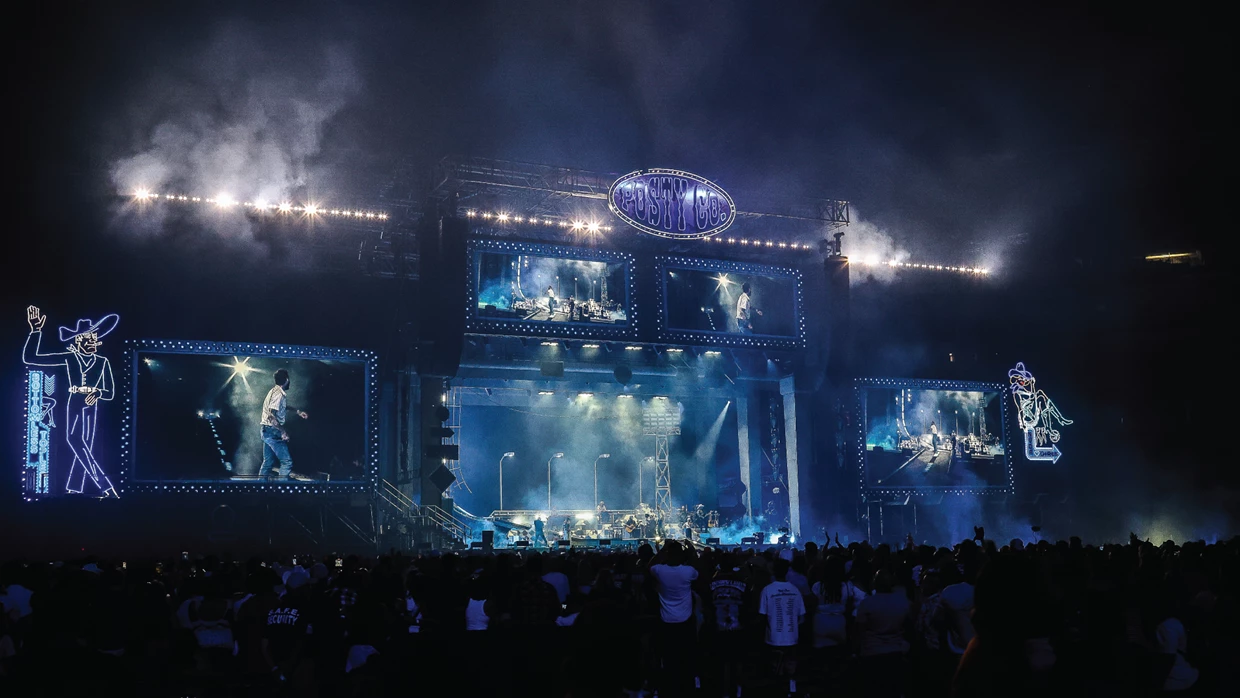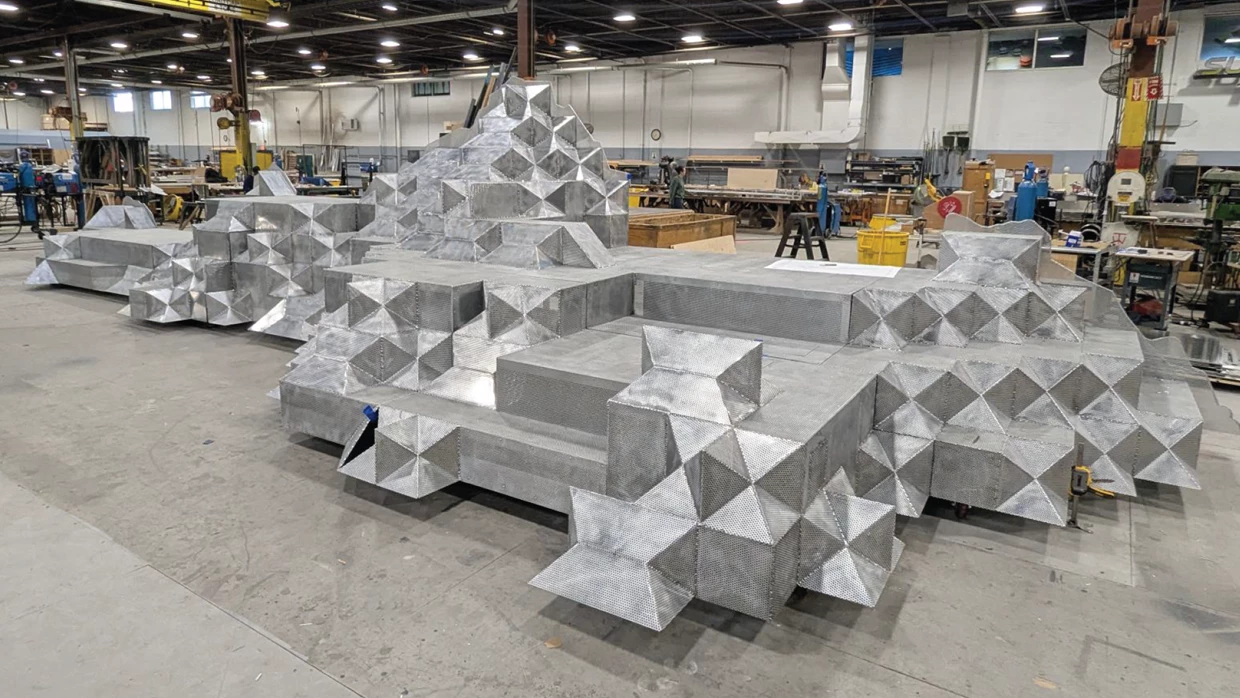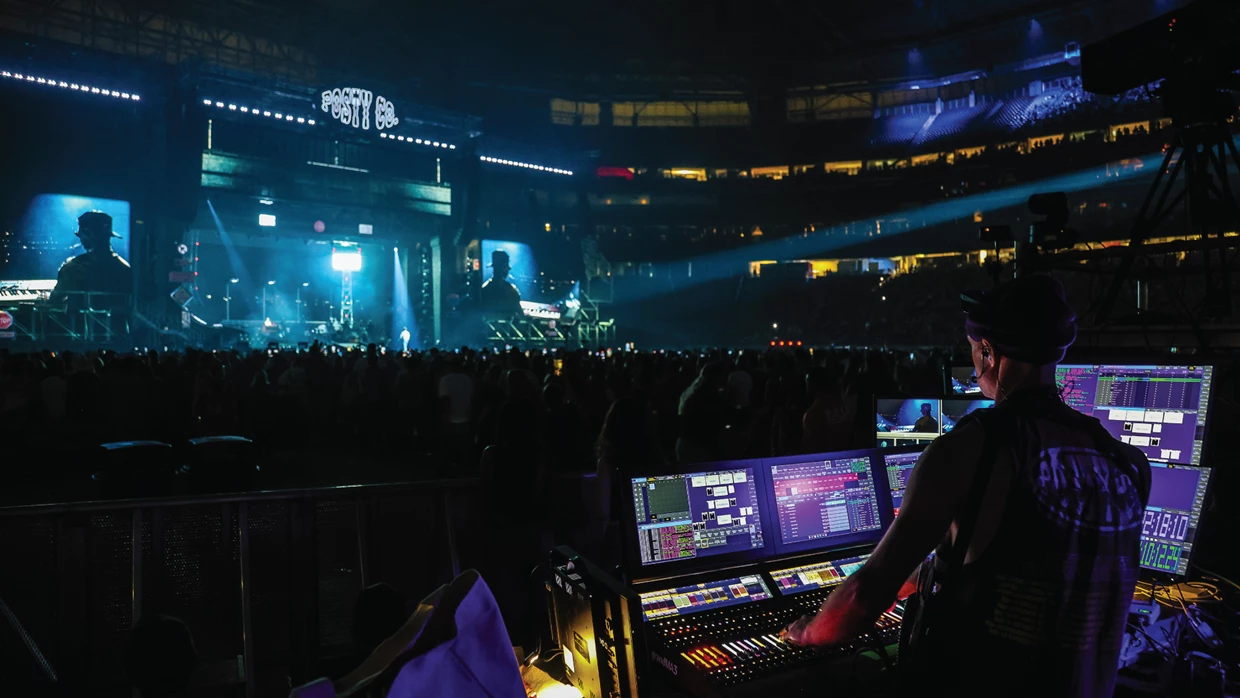
Supporting Talent Beyond Borders – Innovating Gesaffelstein’s Touring Set
From Coachella to Ultra Miami, EDC Las Vegas, HARD Fest, and Outside Lands, PRG turned Gesaffelstein’s creative vision into a scalable touring system, integrating ...

All show photos by Marissa Galin Wayne with Mesmeric Designs
Post Malone's latest trek across North America wasn’t just his biggest tour yet—it was one of the largest, most technically ambitious live productions on the road this year. Dubbed The Big Ass Stadium Tour, it reflected both his evolving sound and the close-knit production partnerships that brought it all to life.
With PRG providing scenic, lighting, video and rigging support, and with design heavyweights like Stufish and Lighting Designer Rob Sinclair on board, the tour felt both intimate and massive. Behind the striking visuals was a complex operation fueled by technical precision.
Visually, the Big Ass Tour features bold architectural staging with a playful, honky-tonk edge. The set features industrial textures, geometric forms and raw materials that evoke both a modern urban landscape and the rugged Americana of Post Malone's recent country-tinged music. We see angular "origami" rock formations complemented by a towering pylon, integrated LED signage, and a sleek, sculptural B-stage. Adding to the roadhouse energy are neon-styled cowboy and cowgirl LED signs along with the buckle-style Posty Co. sign that has become emblematic of the tour.
"This was by far the largest, most intense undertaking I've had in my tenure with Post," said Dennis Danneels, longtime Production Manager for the tour. "It was the biggest show, biggest venues and by far the tightest timeline."
The scenic vision for the tour was driven by Creative Director Dannah Gottlieb, with Ric Lipson and Rachel Duncan from Stufish shaping the design. PRG's Mark Peterson ensured those ambitions could be executed to the highest technical standards.
That condensed schedule meant that scenic elements had to be designed and fabricated with both impact and efficiency in mind. The effort was a collaboration between PRG Scenic in New Windsor, NY, led by Peterson, and PRG Projects in Belgium, which handled the LED road signs. To accommodate the demanding schedule, PRG Scenic fabricated two identical Posty Co. signs, allowing for leapfrogging between cities.
The tour's scenic build also featured 500 meters of LED tape and 150 LED nodes integrated into the signs, as well as nearly 100 sheets of perforated metal with roughly 450,000 holes—a key element that allowed Sinclair's lighting design to illuminate the rock formations on both stages. Custom carting solutions were developed for all units to ensure an efficient truck pack and smooth installation under tight timelines.

"It's about having partners that know how to manufacture a product that's tourable—and how to support it when real-world challenges hit," said Danneels. The PRG team provided ongoing support, even dispatching welders and materials to handle inevitable wear and tear.

Lighting Designer Rob Sinclair, Lighting Director and Lead Programmer Erin Anderson, Touring LD Anthony "Crash" Wayne, and Associate Lighting Director Ben Marx faced a unique challenge: creating a show that delivered intimacy on a stadium scale while accommodating an artist known for his dynamic stage presence.
"A Post Malone show is never the same twice," explained Crash. "We had to design with flexibility in mind."
That philosophy extended to the 1,000+ fixture lighting rig and to PRG's GroundControl Followspot System, which provided Crash precision control in real-time. "The system let operators focus on tracking him, while I managed color and intensity from the console, sculpting him for both the cameras and the crowd."
PRG supplied the full lighting package, including Acme Pixel Line IPs, Astera Titan Tubes, GLP JDC Burst 1s, and Vari-Lite VL3600s. Touring efficiency was key.
"It was all about smart decisions," added Danneels. "We built A and B rig options depending on venue limitations without compromising the production value fans expected."

Veteran Video Director John Moore helmed the video experience for Post Malone, continuing a role he began during the Twelve Carat Tour. For this one, the camera package—featuring Steadicam, rail cam, Grass Valley 4K cameras, and PTZ units—helped strike the balance between cinematic spectacle and raw intimacy.
"The Steadicam changed everything," said Moore. "It allowed Post the freedom to play to that camera and bring fans into his world."
The massive LED package, integrated into the scenic design, included over 500 Infiled Titan X tiles, side walls, header screens, and custom signage—all processed via Novastar and Brompton systems.
"It worked so well because of the collaboration," said Moore. "We piped my camera feeds to Crash so he could adjust lighting on the fly. It's that tight-knit crew—many of us have been together across tours—that made it possible."
For PRG Account Executive Burton Tenenbein, who has supported Post Malone tours for years, that sense of partnership ran deep. Early equipment holds, coordination with manufacturers and a boots-on-the-ground approach ensured that time constraints and evolving design needs were met.
"We knew it was a stadium run before we saw the design," said Tenenbein. "We leveraged relationships with manufacturers to hold gear and offer options. It's how you stay ahead."
Production Coordinator Maria Bermudez emphasized that the care extended beyond equipment and logistics. "Burton's dedication to the crew is what separates him from other vendors. He looks out for his team more than anyone else I’ve seen in the business," she said.
Danneels agreed. "It’s not just about gear. It’s about people. And PRG has people who understand touring, who know how to problem-solve, and who pick up the phone when the clock is ticking."
With the North American leg having wrapped at San Francisco's Oracle Park on July 1, the tour stands as a testament to creative ambition realized through production excellence. And while challenges—from rain delays to venue quirks—inevitably arose, the crew’s problem-solving and collaboration kept the show moving.
"At this scale, it’s about building the right team," said Danneels. "We built something huge in a tiny window. This North American run was a culmination of years of teamwork, trust and shared ambition.”

Creative Director: Dannah Gottlieb
Production Design: Stufish, Ric Lipson and Rachel Duncan
Lighting Designer: Rob Sinclair
Tour Manager: Mark Oglesby
Production Manager: Dennis Danneels
Production Coordinator Maria Bermudez
PRG Account Executive: Burton Tenenbein
PRG Project Managers: Jason Dickie, Jim Rink and Dylan Taylor
Lighting Director and Lead Programmer: Erin Anderson
Touring LD: Anthony "Crash" Wayne
Associate Lighting Director: Ben Marx
Lighting Crew Chief: Terry Mueller
Assistant Crew Chief: Philip "Pip" Schulte
FOH Technician: Harrison Elmon May Jr.
Lighting Dimmer Technician: Joseph Donahue
Lighting Dimmer Technician: Mark Parham
Lighting Dimmer Technician: Brandon Randall
Ground Control Technician: Kody Tipton
Moving Light Technician: Mo Epps
Moving Light Technician: Dennis Kirby
Lighting Technician: Jacob Freed
Lighting Technician: Michael "Mike" Jackson
Lighting Technician: Anthony Reis
Lighting Technician: Joshua Sullivan
Lighting Technician: Jonathan Faile
Climber: Matthew Truesdale
Climber: Zakery Vanderlinden
Advance Lighting Crew Chief: Cecil Nelson III
Advance Lighting Crew Chief: Christopher Galante
Advance Lighting Climber: Pablo Polanco Ibarra
Video - Director: John Moore
Video - Crew Chief: Benjamin Welch
LED Lead: Luke Waldron
LED Technician: Aaron Wade
LED Technician: Jordan Schwarz-Peterson
LED Technician: Michael Quiroga
LED Technician: Michael Vasilaros-Lynch
LED Technician: Victor Davis
LED Technician: Scott Light
LED Technician: Steven Bowen
LED Technician: Travis Shipley
LED Technician: Jose Pacheco
LED Technician: Lorene Kirby
Video EIC (Engineer-In-Charge): Markus Snyder
Video Engineer: Dana Jespersen
Steadicam Op / Rental: Alex Beswick
Railcam: Joe Fugallo